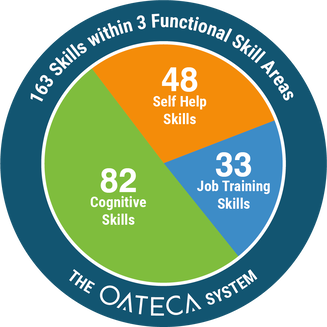|
It’s officially that time of year: back to school! Getting your classroom and supplies ready for the new school year takes a lot of time, planning, and patience — especially when you consider your functional skills curriculum and the ongoing needs of your students. Even if you have already started the school year, there are always ways to improve the structure of your classroom. Whether your students have mild, severe, or profound disabilities, organization is critical. Your students spend a lot of time in the classroom, so the way it looks, feels, and functions can significantly impact their performance throughout the day. Here are a few ways to streamline your classroom for success this year: 1. Setting Up Your Space
Activity Centers Utilize the tables in your classroom for activity centers. For example, one table can be used for small group work, and you can position a few tables to create “circle time.” Additional centers include a Composition (Handwriting) Center, Reading for Comprehension Center, and a Workstation where students can sharpen pencils or shred paper. Make sure to position the tables so you can easily oversee each center from wherever you are in the room. Independent Work Utilize desks for independent work with your students. While this will depend on the ratio of students in your classroom, you might have a desk for each student. Try positioning these with shelving or separators in between, particularly for your students with autism to give them each their own space. If not, designate one of your tables for 1:1 education time. Library Every classroom should have a library, whether your room is general or special education focused. Consider the reading levels and needs of your students. In most cases, it’s beneficial to organize the books into bins or shelves and sort them by theme (i.e., seasons, animals, friendship, etc.) Socialization Area For some students, socialization and playtime are one of the largest struggles; for others, it’s a critical necessity for learning and growth. Playtime and socialization are likely already a vital part of your daily curriculum, so having the appropriate space in your classroom is necessary. Designate a specific location in the room for play, and keep the area structured, organized, and uncluttered. The most important aspect of designating specific areas in your classroom for certain activities is to section off those areas by utilizing tables, shelving, or other separators in your room. This not only keeps your room organized and structured, but also helps your students learn those areas and transition through those spaces more effectively. 2. Visual Learning Resources3. Prepping Your ParaprofessionalsYour class likely includes paraprofessionals, speech therapists, occupational therapists, counselors, and physical therapists, who are all an asset to your everyday instruction and education. If your classroom is center-based (and if you utilize the table layout as mentioned above), it’s a great idea to utilize your paraprofessionals at each workstation. Regularly train your paraprofessionals on the instruction, assessments, and structure of the room. Training limits miscommunications and ensures better education for your students throughout the year. You should also set up regular meetings with the therapists to collaborate and discuss the ongoing needs of your students. 4. Functional Skills CurriculumPlanning functional skills curriculum and instruction can be challenging. As is often the case, many students have different IEP goals and are at different skill levels. Ensuring your assessments are assessable to all is vital, so taking some time to plan or prep the curriculum can set your year up for success. Considering that all students should be assessed initially and regularly throughout the year, your special education curriculum should be modified to meet your student’s ongoing needs.
5. Prepare Your Task BoxesTask boxes are significantly beneficial to your functional skills classroom as they essentially provide activities aligned to your student’s transition and learning goals. These are the perfect tool to reinforce independence while practicing functional and academic skills. If your district uses the OATECA System, you are already provided with these resources and ready-made manipulatives. As you prepare your task boxes, keep in mind the goals and objectives. Consider which skills are lagging in your classroom. After identifying the hole in a specific skill, prepare your symbol-adapted directions and manipulatives necessary for intervention. Regularly Evaluate Your Classroom for Better SuccessAside from structuring and prepping your classroom, you should also go through any old files or papers from the past year and eliminate anything you don’t need this school year. Recycle duplicates of worksheets and shred any confidential work you no longer need.
You should also keep in mind that the layout of your classroom might change as you get to know any new students and their ongoing needs. You might quickly find that the structure or functionality of specific areas or tasks need to be adjusted to meet their needs. Regularly evaluate the layout and collaborate with your paraprofessionals to ensure a more successful classroom for this year!
0 Comments
Your comment will be posted after it is approved.
Leave a Reply. |
ArchivesCategories
All
|
|
Oklahoma Assistive Technology and Educational Consulting Associates, Inc.
|
Your Personal Assistive Technology Professionals
|




 RSS Feed
RSS Feed
